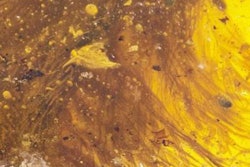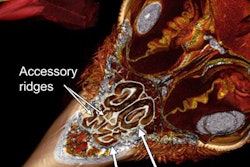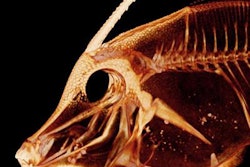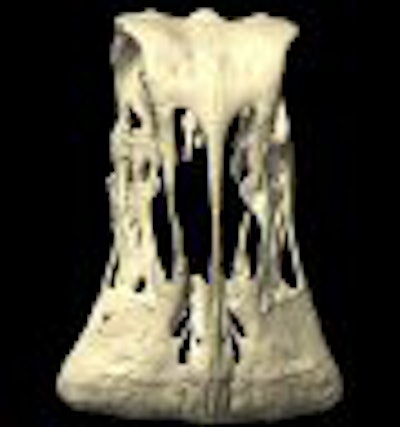
Scientists have used CT and advanced visualization tools to reconstruct the cranial anatomy of a dinosaur that lived more than 110 million years ago. The team's unusual findings cast new light on the dinosaur's feeding function and habits, and led to a featured magazine spread in the December 2007 "Bizarre Dinosaurs" issue of National Geographic.
Based on their imaging findings and reconstructions of the cranial anatomy, the scientists determined that the dinosaur had an "extremely lightweight skull" made up of nearly translucent bones and a mouth with hundreds of teeth, perfect for munching greenery -- think of it as a living lawnmower for the Flintstones.
French paleontologists discovered the first bones of the dinosaur in the Sahara in present-day Niger, Africa, in the 1950s. But in 1997, a team led by Paul Sereno, Ph.D., from the University of Chicago in Illinois found the skull bones and eventually collected about 80% of the skeleton, according to a statement by the National Geographic Society, which funded part of the group's current research. Sereno and his team later named the species Nigersaurus taqueti after French paleontologist Philippe Taquet.
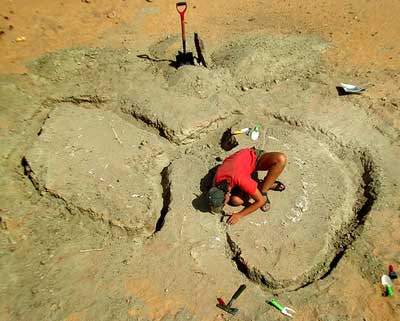 |
| Partial skeleton of an adult Nigersaurus taqueti discovered during the 2000 expedition to Niger. Expedition member Gabrielle Lyon is seated inside the curve of the proximal caudal vertebrae of a skeleton planed flat by wind-blown sand at a site in Gadoufaoua, Ténéré Desert, Niger. Photo © Mike Hettwer, courtesy of Project Exploration. |
Sereno is a professor in the department of organismal biology and anatomy at the University of Chicago. His colleagues are from the University of Michigan in Ann Arbor, the College of Osteopathic Medicine at Ohio University in Athens, the Jackson School of Geological Sciences at the University of Texas at Austin, and the Institute for Human Science at the University of Niamey in Niamey, Niger.
Prehistoric vegetarian
From the Early Cretaceous period (about 144 to 127 million years ago), Nigersaurus taqueti is classified as a rebbachisaurid sauropod, a four-footed herbivore with a small head, distinctive teeth, and a long neck and tail. Nigersaurus was relatively small for a sauropod, measuring about 30 feet in length with an estimated body mass similar to that of an elephant.
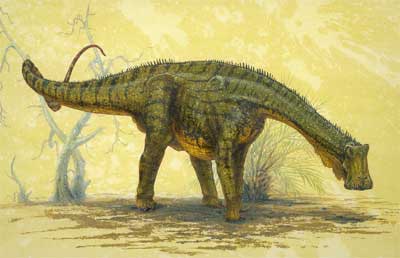 |
| Above, Nigersaurus taqueti would have spent most of the time browsing plants close to the ground. Illustration © Todd Marshall. Below, the Nigersaurus skeleton. Photo © Gabrielle Lyon. Bottom, skeletal map of Nigersaurus showing all of the bones discovered to date. Human silhouette equals 1.68 meters (5 feet 6 inches). Illustration © Carol Abraczinskas and Paul Sereno. All images courtesy of Project Exploration. |
 |
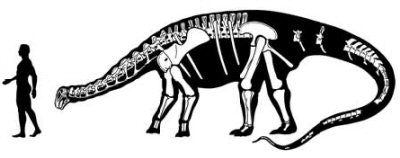 |
"Nigersaurus was one of the most common large herbivores of its day, judging from the number of specimens collected," the Sereno and colleagues wrote (Public Library of Science [PLoS] ONE, November 21, 2007).
"The majority of rebbachisaurid finds to date ... are relatively incomplete, especially with regard to the skull," they wrote. "Fossils of the Early Cretaceous dinosaur, Nigersaurus taqueti, document for the first time the cranial anatomy of a rebbachisaurid sauropod."
And current technology, including CT, stereolithography, and molding and casting techniques, helped illustrate how the dinosaur appeared and functioned millions of years ago.
Modern imaging
CT scans of Nigersaurus' cranial bones and skull were performed at the High-Resolution X-ray Computed Tomography Facility at the University of Texas at Austin. The scans were then used to make stereolithographic (STL) prototypes by Laser Modeling of Schaumberg, IL.
CT was used to obtain internal and cross-sectional morphologic information and replicate the fragile bones without damaging them, according to the authors. "CT also allowed us to render the first endocast for a sauropod, preserving portions of the olfactory bulbs, cerebrum, and inner ear, the latter permitting us to establish habitual head posture," they wrote.
|
Having trouble viewing this clip? Click here to view full size clip or to change format. |
| Skull model of Nigersaurus taqueti showing downturned posture. © Lawrence Witmer, courtesy of Project Exploration. |
"The delicate construction of the skull is well-seen in transverse cross-section in which the total area of all bone connecting the muzzle to the occipital unit of the skull is approximately 1.0 cm²," the authors wrote. "These delicate connecting struts of bone, which rarely exceed 2 mm in thickness, must resist stress generated by the distally located tooth rows."
Osteological evidence from the occiput, inner ear, and cervical vertebrae in the Nigersaurus indicates a downward posture of the head and neck, with its muzzle located close to the ground, according to the authors. "Habitual head posture was established on the basis of the lateral semicircular canal of the inner ear, which was rendered from µCT scans," they wrote.
Cretaceous dental exam
Sereno's group also used CT to give Nigersaurus' a postmortem dental exam of sorts, imaging its extensive tooth batteries.
"We used µCT to reveal the internal packing of the battery and assist in creating an accurate digital reconstruction of an upper and lower replacement series," the team wrote. "In the center of upper and lower batteries, as many as 10 teeth are present in a single column extending deep within each jaw bone. The upper series has about 60 tooth columns (four premaxillary, 25 maxillary per side), and the lower series has 68 tooth columns (34 per dentary). In sum, there are more than 500 active and replacement teeth in a single skull."
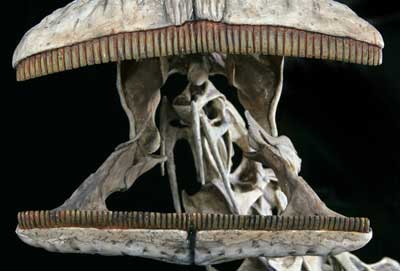 |
| With tooth rows composed of many small, chisel-tipped teeth, the jaws of Nigersaurus closed like dinosaurian scissors, cropping a mouthful of plants with each bite. Photo © Mike Hettwer, courtesy of Project Exploration. |
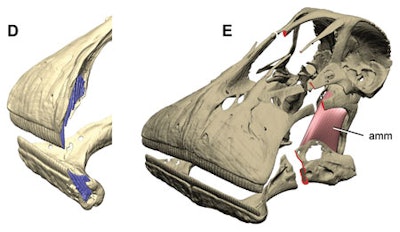 |
| Skull of Nigersaurus taqueti. (D) premaxillary and dentary tooth series (blue) reconstructed from µCT scans. (E) skull reconstruction in anterolateral and dorsal view cut at midlength between muzzle and occipital units (cross-section in red) with the adductor mandibulae muscle (amm) shown between the quadrate and surangular. Sereno PC, Wilson JA, Witmer LM, Whitlock JA, Maga A, et al. (2007) Structural Extremes in a Cretaceous Dinosaur. PLoS ONE 2(11): e1230 doi:10.1371/journal.pone.0001230. |
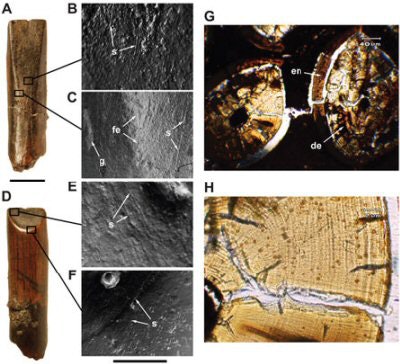 |
| Crown form, wear pattern, and microstructure in Nigersaurus taqueti. Wear facets and surface detail is from a worn crown, and enamel and dentine microstructure is from left premaxillary teeth in cross-section. (G) Transverse thin section of two successive premaxillary crowns showing thickened labial enamel and circumferential incremental lines of von Ebner (lines in the peritubular dentin of the tooth that correspond to the daily rate of dentin formation) in the dentine. (H) Magnified view of the older (left) crown showing approximately 60 incremental lines of von Ebner. Abbreviations: de, dentine; en, enamel. Sereno PC, Wilson JA, Witmer LM, Whitlock JA, Maga A, et al. (2007) Structural Extremes in a Cretaceous Dinosaur. PLoS ONE 2(11): e1230 doi:10.1371/journal.pone.0001230. |
Based on thin sections of an intact premaxillary tooth battery from another Nigersaurus specimen, the team estimated a rapid tooth replacement rate of about one month. "The shearing action of its jaws ... ground down crowns at a faster rate than ever recorded among dinosaurian herbivores and accomplished this dental degradation in the most challenging location from a biomechanical perspective -- at the distal end of its jaws, as far as possible from the jaw joint and adductor musculature," Sereno and colleagues wrote.
|
Having trouble viewing this clip? Click here to view full size clip or to change format. |
| Maxilla tooth battery of the Nigersaurus taqueti. © Lawrence Witmer, courtesy Project Exploration. |
Even with its featherweight skull, the species was able to handle the sustained impact of its tooth-to-tooth shearing, they noted. "Somehow this masticatory apparatus was able to grow and maintain a body mass grossly commensurate with that of an average elephant (ca. 4 tons)," the authors wrote.
Extreme dinosaur
Sereno's team was also surprised to find the dinosaur had an unusually small brain.
"Brain features were studied via cranial endocasts taken from the exceptionally preserved brain case using both traditional silicone peels and volumetric rendering from µCT scans," the group wrote. Cerebral and total brain volumes were estimated digitally from a CT scan, and indicate that Nigersaurus had a relatively small brain -- 40% to 80% of the size expected for a reptile of its body size.
Other findings suggest the dinosaur was "barely able to lift its head above its back," according to the National Geographic Society. "Nigersaurus operated more like a Mesozoic cow than a reptilian giraffe, mowing down mouthfuls of greenery that consisted largely of ferns and horsetails."
"Nigersaurus taqueti shows extreme adaptations for a dinosaurian herbivore, including a skull of extremely light construction, tooth batteries located at the distal end of the jaws, tooth replacement as fast as one per month, an expanded muzzle that faces directly toward the ground, and hollow presacral vertebral centra with more air sac space than bone by volume," the authors concluded.
In addition to being featured in the December 2007 "Bizarre Dinosaurs" issue of the National Geographic magazine, Nigersaurus with its fossils and reconstructed skeleton and skull is on display at an exhibit at the National Geographic Museum at Explorers Hall in Washington, DC, through March 18, 2008.
By Heather Hokenson
AuntMinnie.com staff writer
December 19, 2007
Related Reading
Cold case closed: CT solves iceman's cause of death, July 4, 2007
Scan artist: Radiologist uses CT to reveal mystery of antiquities, October 25, 2005
CT helps unwrap mummy mystery, March 29, 2005
MDCT solves 400-year-old mystery, November 29, 2004
Mummy dearest: CT helps archaeologists dig deeper, April 23, 2003
Copyright © 2007 AuntMinnie.com





